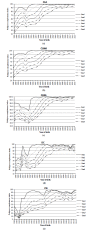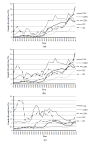Evaluation of inbreeding and genetic variability of five pig breeds in czech republic
- PMID: 25557673
- PMCID: PMC4283186
- DOI: 10.5713/ajas.14.0251
Evaluation of inbreeding and genetic variability of five pig breeds in czech republic
Abstract
The complex analysis of the pedigree records of Czech Landrace (CLA), Czech Large White-dam line (CLWd), Czech Large White-sire line (CLWs), Duroc (DC), and Pietrain (PN) was performed to determine trends of genetic diversity (GD), and to find the main sources of the GD loss. The total size of the pedigree was 132,365, 391,151, 32,913, 13,299, and 7,160 animals in CLA, CLWd, CLWs, DC, and PN, respectively. Animals born in the years 2011 through 2013 were assumed as the reference population. The average pedigree completeness index for one generation back was 95.9%, 97.4%, 91.2%, 89.8%, and 94.2% for appropriate breeds. Number of ancestors explaining 100% of gene pool was 186, 373, 125, 157, and 37 in CLA, CLWd, CLWs, DC, and PN, respectively. The relative proportion of inbred animals (58%, 58%, 54%, 47%, and 25%), the average inbreeding (2.7%, 1.4%, 2.5%, 3.6%, and 1.3%) and the average co-ancestry (3.1%, 1.6%, 3.3%, 4.2%, and 3.3%) were found over the past decade in analysed breeds. The expected inbreeding under random mating increased during the last 10 years in CLWs and PN and varied from 1.27% to 3.2%. The effective population size computed on the basis of inbreeding was 76, 74, 50, 35, and 83 in 2012 in CLA, CLWd, CLWs, DC, and PN, respectively. The shortest generation interval (1.45) was observed for CLWd in sire to son selection pathway. The longest generation interval obtained PN (1.95) in sire to daughter pathway. The average relative GD loss within last generation interval was 7.05%, 4.70%, 9.81%, 7.47%, and 10.46%, respectively. The relative proportion of GD loss due to genetic drift on total GD loss was 85.04%, 84.51%, 89.46%, 86.19%, and 83.68% in CLA, CLWd, CLWs, DC, and PN, respectively. All breeds were characterized by a high proportion of inbred animals, but the average inbreeding was low. The most vulnerable breeds to loss of GD are DC and PN. Therefore, a breeding program should be more oriented to prevent the increase of GD loss in these breeds.
Keywords: Effective Population Size; Expected Inbreeding; Genetic Diversity Loss; Number of Founders; Pedigree Analysis; Pedigree Completeness; Pig.
Figures




Similar articles
-
Pedigree-based analyses of changes in genetic variability in three major swine breeds in Taiwan after a disease outbreak.Transl Anim Sci. 2022 Apr 13;6(2):txac043. doi: 10.1093/tas/txac043. eCollection 2022 Apr. Transl Anim Sci. 2022. PMID: 35592093 Free PMC article.
-
Monitoring changes in the demographic and genealogical structure of the main Spanish local beef breeds.J Anim Sci. 2014 Oct;92(10):4364-74. doi: 10.2527/jas.2013-7420. Epub 2014 Sep 2. J Anim Sci. 2014. PMID: 25184851
-
Inbreeding and genetic diversity in three imported Swine breeds in china using pedigree data.Asian-Australas J Anim Sci. 2013 Jun;26(6):755-65. doi: 10.5713/ajas.2012.12645. Asian-Australas J Anim Sci. 2013. PMID: 25049847 Free PMC article.
-
Reproductive Performance, Inbreeding, and Genetic Diversity in Montbeliarde Dairy Cattle Obtained by Absorption Crossing.Animals (Basel). 2025 Jan 23;15(3):322. doi: 10.3390/ani15030322. Animals (Basel). 2025. PMID: 39943092 Free PMC article.
-
Genetic diversity, inbreeding and breeding practices in dogs: results from pedigree analyses.Vet J. 2011 Aug;189(2):177-82. doi: 10.1016/j.tvjl.2011.06.016. Epub 2011 Jul 6. Vet J. 2011. PMID: 21737321 Review.
Cited by
-
Genetic Variability and Management in Nero di Parma Swine Breed to Preserve Local Diversity.Animals (Basel). 2020 Mar 24;10(3):538. doi: 10.3390/ani10030538. Animals (Basel). 2020. PMID: 32213904 Free PMC article.
-
The Nero Lucano Pig Breed: Recovery and Variability.Animals (Basel). 2021 May 7;11(5):1331. doi: 10.3390/ani11051331. Animals (Basel). 2021. PMID: 34067067 Free PMC article.
-
Simultaneous testing of rule- and model-based approaches for runs of homozygosity detection opens up a window into genomic footprints of selection in pigs.BMC Genomics. 2022 Aug 6;23(1):564. doi: 10.1186/s12864-022-08801-4. BMC Genomics. 2022. PMID: 35933356 Free PMC article.
-
Insight into the Current Genetic Diversity and Population Structure of Domestic Reindeer (Rangifer tarandus) in Russia.Animals (Basel). 2020 Jul 30;10(8):1309. doi: 10.3390/ani10081309. Animals (Basel). 2020. PMID: 32751575 Free PMC article.
-
Pedigree Analysis of Warmblood Horses Participating in Competitions for Young Horses.Front Genet. 2021 Apr 15;12:658403. doi: 10.3389/fgene.2021.658403. eCollection 2021. Front Genet. 2021. PMID: 33936176 Free PMC article.
References
-
- Berg P. User’s Guide. Institute of Arhus, Institute of Genetic and Biotechnology; Tjele, Denmark: 2012. EVA version 1.75. Evolutionary algorithm for mate selection.
-
- Boichard D, Maignel L, Verrier E. The value of using probabilities of gene origin to measure genetic variability in a population. Genet Sel Evol. 1997;29:5–23.
-
- Boichard D. PEDIG: a fortran package for pedigree analysis suited for large populations. Proc. of the 7th World Congress on Genetics Applied to Livestock Production (WCGALP); Castanet-Tolosan, France [CD-Rom]: INRA; 2002. pp. 19–23.
-
- Caballero A, Toro MA. Interrelations between effective population size and other tools for management of conserved populations. Genet Res. 2000;75:331–343. - PubMed
LinkOut - more resources
Full Text Sources
Other Literature Sources
Miscellaneous

